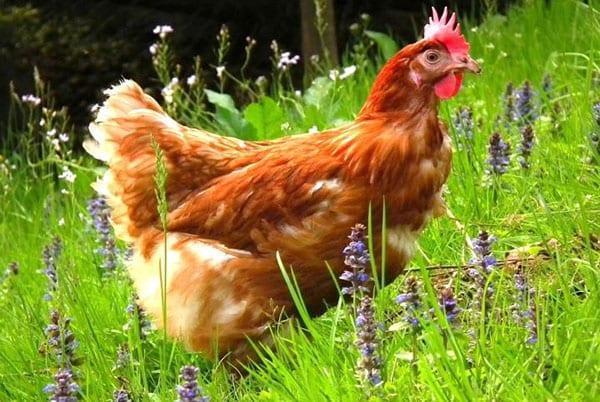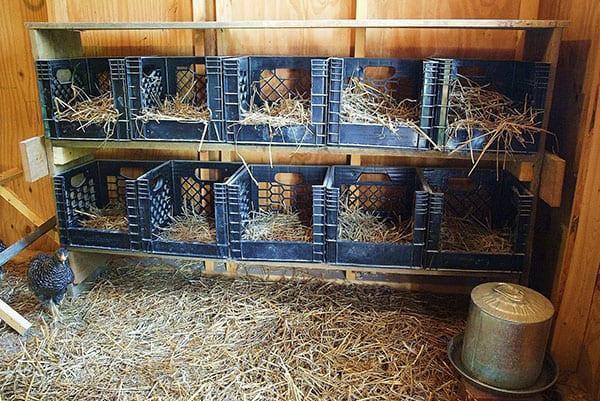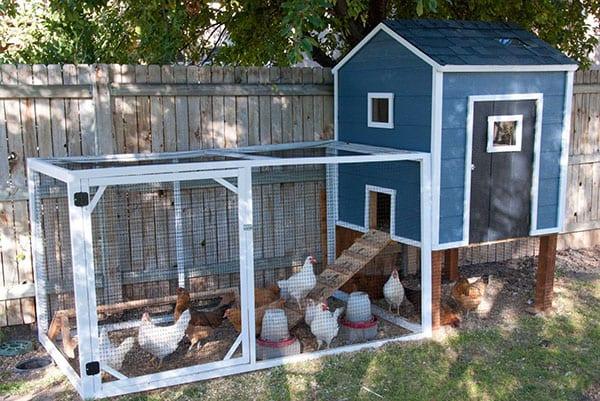Breeding chickens from scratch
 So you've decided to raise your own chickens. After reading this article, you can learn this process from scratch.
So you've decided to raise your own chickens. After reading this article, you can learn this process from scratch.
There are many advantages to raising your own chickens. Homemade eggs are a real temptation. They are fresher and tastier than those sold in stores, and are ideal for baking. The shells can be thrown directly into the compost heap. Birds are on their own for most of the day. They walk around the yard, peck at beetles and worms, and then we collect these wonderful eggs.
However, remember: nothing good comes easily.
Preparing for your own production

- First you need chicken coop... A feeder, drinker and nest box for each three birds should be installed in it. Its size should be free to stand inside, collect eggs and shovel droppings.
- Chickens need food and water daily. The food costs about $ 20 for a 50-pound bag from my vendors. But how long it will last depends on the number of your birds.
- In spring, summer and early autumn, chickens spend 12-14 hours outdoors. You will be able to collect eggs once or sometimes twice a day.
- Be prepared to shovel manure all year round.
- If you are planning to leave for a long time, then you need to hire a reliable nurse for the period of absence. By the way, it is often easier to find teeth in a chicken than such a person.
How to start raising chickens
 These are very sociable birds, so the number of 4-6 individuals will be optimal. Make sure that the space for each of them is at least 2 square meters. feet. The more space, the happier and healthier the chicken will be. If this is neglected, then birds will get sick more often and lose feathers.
These are very sociable birds, so the number of 4-6 individuals will be optimal. Make sure that the space for each of them is at least 2 square meters. feet. The more space, the happier and healthier the chicken will be. If this is neglected, then birds will get sick more often and lose feathers.
Any chicken needs plenty of room to spread its wings: for example, a 20 x 5-foot paddock, or an entire backyard. (My pets spend a lot of time outdoors. They have enough space to lie in the dust and soak up the sun).
 In any case, the entire space must be fenced in to keep the chickens inside and not to let the predators outside. Thus, include wire fence and support poles in your shopping list.
In any case, the entire space must be fenced in to keep the chickens inside and not to let the predators outside. Thus, include wire fence and support poles in your shopping list.
All this costs money. Materials for the construction and decoration of a chicken coop with a pen will cost $ 300 - $ 400. If you do not have sufficient carpenter skills, then you will also need skilled wage workers. Want to grow your flock? Chicks require a brooder lamp for heating. As they say, chickens are counted in the fall.
Purchase of chickens of different ages
You can buy birds at different stages of development. It all depends on how long you are willing to wait for the eggs:
- Daily chicks can be purchased in incubators. Most farmer suppliers take 1-2 orders for chickens per year. Thus, you can pick them up the moment you go to get food. Each will cost you $ 3. In this case, the eggs will have to wait 6 months.

- Pullets at 20 weeks of age are ready for the first lay. They are more expensive than day old chicks, but you can get eggs much earlier. Such chickens can be immediately placed in a chicken coop, they are all female. Also purchased at hatchery stations from suppliers.

- With mature hens hens the situation is more difficult. Unless someone you know wants to replace their old chickens and sell them to you. Otherwise, you will most likely only find chicks or pullets.(Broiler chickens are not good candidates for the flock as they are kept in cages and used to produce eggs in such numbers that they die at 2–3 years of age).

Raising chickens
 Taking care of your chicks is easy, and you don't need to think carefully about each step. Along with compound feed and clean water, chicks need a draft-proof brooder. Always have a red brooding lamp on. It will maintain a temperature of 92 ° F two inches above the surface of the floor (also reducing the likelihood of feather pecking and cannibalism among chicks).
Taking care of your chicks is easy, and you don't need to think carefully about each step. Along with compound feed and clean water, chicks need a draft-proof brooder. Always have a red brooding lamp on. It will maintain a temperature of 92 ° F two inches above the surface of the floor (also reducing the likelihood of feather pecking and cannibalism among chicks).
When the chicks are shedding, start reducing the temperature by 5 degrees per week until they are 6 weeks old. Then replace the starter with a growth diet.
Breeding
Instead of buying chicks every year, you can breed them yourself. Of course, you need a rooster to get fertilized eggs. Check that the room is correctly zoned: the rooster should not be near the chickens while incubating, they will do just fine without him.
 You will also need a brood hen. Incubation is the hen's instinct to sit on eggs until they begin to hatch. We always had a couple of chickens that sat tightly in the nest and began to peck when we tried to pick up the eggs. Bantam chickens are famous hens and they also hatch the eggs of other layers.
You will also need a brood hen. Incubation is the hen's instinct to sit on eggs until they begin to hatch. We always had a couple of chickens that sat tightly in the nest and began to peck when we tried to pick up the eggs. Bantam chickens are famous hens and they also hatch the eggs of other layers.
 A home incubator is a great alternative to a brood hen. From the start of the incubation period to hatching, 21 days pass. (By the way, there are more favorable dates for the beginning of incubation of eggs or for placing them in an incubator). Watch out for your future pets, because if soon after hatching a chick from an egg, you do not get it out of the incubation box, it will die of dehydration and hunger. We had a case when one hatched and tried to crawl through the protective mesh of the fan. As a result, he died from the blades.
A home incubator is a great alternative to a brood hen. From the start of the incubation period to hatching, 21 days pass. (By the way, there are more favorable dates for the beginning of incubation of eggs or for placing them in an incubator). Watch out for your future pets, because if soon after hatching a chick from an egg, you do not get it out of the incubation box, it will die of dehydration and hunger. We had a case when one hatched and tried to crawl through the protective mesh of the fan. As a result, he died from the blades.
Some tips for a happy chicken coop
For successful breeding of chickens, consider my recommendations:
- There is an opinion that it is impossible to keep birds of different ages in the same flock. However, we have never had problems with changing old chickens to young ones, and vice versa. They successfully hatched chicks. Often times, pecking occurs when there are too many birds in a small area, so give your pets more space.
- There should always be a source of water and food near the chicks. Place a 4-inch layer of pine sawdust on the floor and lay a few sheets of newspaper on top of it. Then scatter the chicken feed around the paper and fill the feeders. Remove one leaf each day, and by the time the last is left, the chicks should have learned to feed from the feeder.

- Use only red lamps, as no wounds can be seen under their light. Under normal lighting, any blood stain immediately triggers the pecking reflex. The chickens will peck each other to death with joy and speed.
- Place cardboard sheets in the corners of the pen to round the walls. (you can also make a round corral) This will prevent chicks from huddling together and will prevent possible choking.
- Make sure drinkers are clean and shallow, otherwise chicks may drown. My suppliers recommend 1 gallon drinkers per hundred chicks. I always had two or three to avoid crowding.
- For pullets, I used one drinker for 6 - 8 birds and a feeder that was long enough to accommodate everyone at once.
Collection, cleaning and storage of chicken eggs

Once you try farm eggs, it will be extremely difficult to return to factory eggs. Regardless of whether they are produced by free-range chickens or not, the yolk will be bright and the taste is simply great.To make the shells stronger, add ground oyster shells or other calcium supplements available at farm stores to the chicken feed.
Collect eggs every morning: Loud clucking is a clear sign of the end of lay. I usually check the hens again in the afternoon.
Chickens love to eat eggs as much as we do. Most egg-eating chickens learn this from broken shells and, as a result, begin to break eggs on their own. Chickens are opportunistic and will nibble on anything that looks edible. By immediately throwing out broken eggs and straw where they were lying, you can prevent this bad habit from developing in the herd. A chicken that has begun to eat eggs does not respond to treatment. Moreover, others can follow her example. You want to eat eggs yourself, not feed the birds!
 You can determine in advance the color of the egg that the hen is hatching by the color of its ears. Yes, exactly, ears. Unlike humans, birds have auditory organs inside the head, so notice the oval skin next to the ear canal. If it is white, then the hen hatches white eggs, if it is red, then the eggs will be brown. There is no difference in taste or composition between the two, but white eggs appear lighter when used with dyes on Easter.
You can determine in advance the color of the egg that the hen is hatching by the color of its ears. Yes, exactly, ears. Unlike humans, birds have auditory organs inside the head, so notice the oval skin next to the ear canal. If it is white, then the hen hatches white eggs, if it is red, then the eggs will be brown. There is no difference in taste or composition between the two, but white eggs appear lighter when used with dyes on Easter.
Egg cleaning and storage
 The eggshell is coated with a "bloom" that is a natural defense against bacteria. If possible, do not rinse it off, but wipe it with a dry, rough cloth.
The eggshell is coated with a "bloom" that is a natural defense against bacteria. If possible, do not rinse it off, but wipe it with a dry, rough cloth.
Small stains with manure residues can be removed pointwise with a damp cloth. Completely dirty eggs can only be washed in warm water by scrubbing the droppings with a natural bristle brush. The cold water makes the egg shrink inside the shell and attracts germs.
Let the moisture evaporate completely before removing the eggs. (I like to sort them by color, dark to light)
Place the product in egg cartons marked with the current date and store in the refrigerator on the shelf. Do not store them at the door, because each time you open them, the eggs will beat. If the boxes are only partially filled, you can use a pencil to write on each egg the date it was harvested. Store in the refrigerator for no more than a month. Incubator eggs must not be refrigerated. keep them separately in a cool dry place for no more than 7 days.
Tips for culinary experts: To cook stuffed eggs, take one week or older, but not harvested in the morning of the same day. They clean better.
Farm chickens live from 4 to 7 years and lay eggs all this time. However, there is a break every year in winter due to the lack of sunlight needed for egg-laying. Chickens return to their usual rhythm with the arrival of spring.